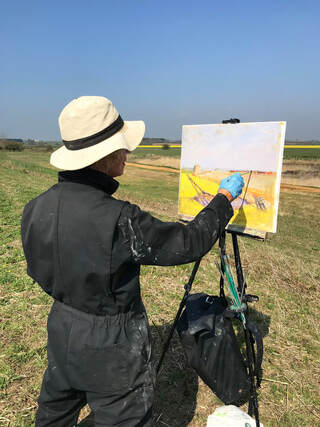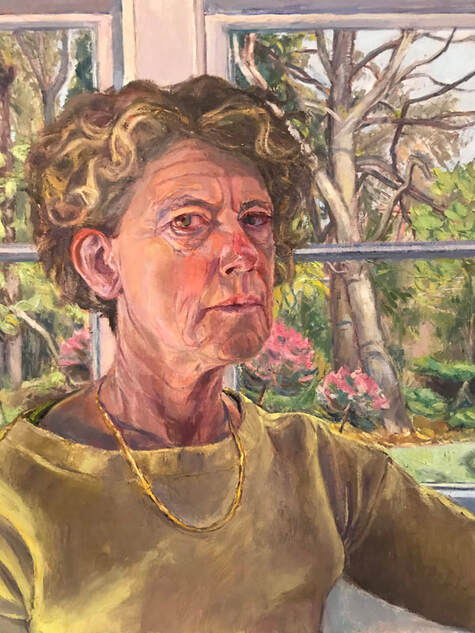Caroline Poole Artist & Painter
|
Introduction
Caroline Poole is a Suffolk based artist who paints from direct observation. Her work is exhibited locally, nationally and internationally and is in many private collections. Her current focus is on the disappearing coastal landscape of Suffolk, which she paints en plein air on an almost daily basis whenever the weather and tides permit. Background & Training
Caroline was born in 1954 and grew up in Notting Hill in London. She now lives most of the time in Suffolk and has been coming to the area since 1964. Caroline trained with the painter Nahem Shoa, who is especially well known for his portraits of black people, which have been acquired by many major museums around England. |
Working Practice
Caroline trained in the Carlos Duran method who taught John Singer Saergent, his method was based on the technique of the great 17th Century master Diego Velazquez.
It is a way of painting from life with no under-drawing but rather painting the tone of the tone, the shape of the shape and the colour of the colour. Seeing the colour shape and tone as a whole and painting all parts equally.
Caroline works directly onto the canvas, blocking in big masses, working up all areas of the canvas at the same time because no area is more important, each part of the picture informs how to paint the other. For example, the highlight on something tells her how much darker other things are to make that particular highlight glow. She says: “A wonderful example of this can be seen in the “The Millstream, Flatford”, by Constable where the highlight on the man’s coat and on the house glows in relation to the tones in the other areas.”
Caroline says “It is really about painting what you see and not what you think you see.” It is a very direct way of painting nature and Constable used it in his sketches. Like Constable, Caroline observes and scrutinises the landscape and subjects around her.
Painting directly from life involves connecting our hand and eye and turning off our natural thought processes, which can interfere with what we actually perceive. The practice of drawing and painting requires a level of attentiveness and concentration that needs constant nurturing as our brains attempt to rewrite our observations. Lose concentration and what you paint is what you thought you saw, not what you are seeing in that moment. This is the primary challenge that all artists face when painting from observation, to capture the truth of something witnessed in a given time.
Painting landscapes en plein air requires physical and mental strength, discipline and a degree of obsession to complete a painting. Caroline spends much of her time painting en plein air, battling the elements in all but the worst of weathers. Moreover, often her subject matter moves and/or is moved by the wind and sea and is also affected by the changing light. This presents many challenges, so often her paintings take many months to complete. Caroline relentlessly returns to the same spot on at the same time of day when the tides and weather permit.
Caroline trained in the Carlos Duran method who taught John Singer Saergent, his method was based on the technique of the great 17th Century master Diego Velazquez.
It is a way of painting from life with no under-drawing but rather painting the tone of the tone, the shape of the shape and the colour of the colour. Seeing the colour shape and tone as a whole and painting all parts equally.
Caroline works directly onto the canvas, blocking in big masses, working up all areas of the canvas at the same time because no area is more important, each part of the picture informs how to paint the other. For example, the highlight on something tells her how much darker other things are to make that particular highlight glow. She says: “A wonderful example of this can be seen in the “The Millstream, Flatford”, by Constable where the highlight on the man’s coat and on the house glows in relation to the tones in the other areas.”
Caroline says “It is really about painting what you see and not what you think you see.” It is a very direct way of painting nature and Constable used it in his sketches. Like Constable, Caroline observes and scrutinises the landscape and subjects around her.
Painting directly from life involves connecting our hand and eye and turning off our natural thought processes, which can interfere with what we actually perceive. The practice of drawing and painting requires a level of attentiveness and concentration that needs constant nurturing as our brains attempt to rewrite our observations. Lose concentration and what you paint is what you thought you saw, not what you are seeing in that moment. This is the primary challenge that all artists face when painting from observation, to capture the truth of something witnessed in a given time.
Painting landscapes en plein air requires physical and mental strength, discipline and a degree of obsession to complete a painting. Caroline spends much of her time painting en plein air, battling the elements in all but the worst of weathers. Moreover, often her subject matter moves and/or is moved by the wind and sea and is also affected by the changing light. This presents many challenges, so often her paintings take many months to complete. Caroline relentlessly returns to the same spot on at the same time of day when the tides and weather permit.
Influences & Inspiration
Constable is one of Caroline’s greatest inspirations and she is trying to take a traditional method of painting into the present day. Caroline’s paintings are “picturesque” albeit with a much rawer aesthetic than the traditional Suffolk landscapes which were born out of Constable and Gainsborough.
Women artists have been neglected throughout history. Women artists have made a significant contribution to the history of art and only recently has this been recognised. Caroline says: “As a woman artist, it inspires me to be even more ambitious in my work.”.
Constable is one of Caroline’s greatest inspirations and she is trying to take a traditional method of painting into the present day. Caroline’s paintings are “picturesque” albeit with a much rawer aesthetic than the traditional Suffolk landscapes which were born out of Constable and Gainsborough.
Women artists have been neglected throughout history. Women artists have made a significant contribution to the history of art and only recently has this been recognised. Caroline says: “As a woman artist, it inspires me to be even more ambitious in my work.”.
|
Subject Matter
Caroline’s particular interest at the moment is recording the loss of the coastal pines, the cliffs, World War II defences and the groynes, all of which are rapidly disappearing from the Suffolk landscape. Climate change is subject close to Caroline’s heart as our connection to nature is so strong. That connection means she feels the loss of every tree that leaves the collapsing shoreline. It’s not uncommon for Caroline to spend many months on a painting and to find that during that time the subject, e.g. a tree, has been moved by the sea or taken by it. Caroline is determined to record the dramatic changes in the coastline due to climate change around Bawdsey which is a topic that needs highlighting given that the area is eroding more quickly than anywhere else in Europe. She has been painting the changing landmarks, beautiful landscape and coastal scenes around Bawdsey for decades. Caroline also works and finds inspiration in Adalucia, Spain and in Zanzibar, Africa where the light is often more consistent and the colours more vivid. In her studio, she often paints friends and herself. As a woman artist, she aims to portray herself as truthfully as she can. In the winter, when the weather is bad, she focuses on painting varying still life subjects. |
Exhibitions
Caroline’s work has been included in several museum shows in Ipswich, Coventry and Hartlepool alongside paintings by Constable, Gainsborough, Monet, Freud, Bomberg and Auerbach.
She has exhibited with the Royal Society of Portrait Painters, the Pastel Society and the Ruth Borchard national self portrait prize.
She is represented by one of Suffolk’s leading gallery, Gallery East in Woodbridge and has work in many private collections.
Caroline’s work has been included in several museum shows in Ipswich, Coventry and Hartlepool alongside paintings by Constable, Gainsborough, Monet, Freud, Bomberg and Auerbach.
She has exhibited with the Royal Society of Portrait Painters, the Pastel Society and the Ruth Borchard national self portrait prize.
She is represented by one of Suffolk’s leading gallery, Gallery East in Woodbridge and has work in many private collections.


